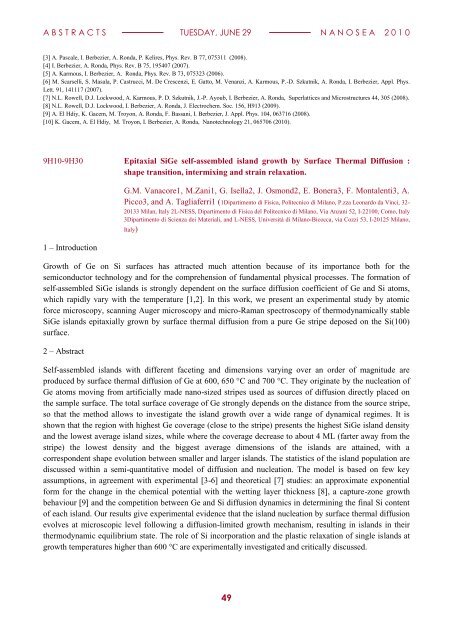book of abstracts - IM2NP
book of abstracts - IM2NP
book of abstracts - IM2NP
You also want an ePaper? Increase the reach of your titles
YUMPU automatically turns print PDFs into web optimized ePapers that Google loves.
A B S T R A C T S TUESDAY, JUNE 29 N A N O S E A 2 0 1 0<br />
[3] A. Pascale, I. Berbezier, A. Ronda, P. Kelires, Phys. Rev. B 77, 075311 (2008).<br />
[4] I. Berbezier, A. Ronda, Phys. Rev. B 75, 195407 (2007).<br />
[5] A. Karmous, I. Berbezier, A. Ronda, Phys. Rev. B 73, 075323 (2006).<br />
[6] M. Scarselli, S. Masala, P. Castrucci, M. De Crescenzi, E. Gatto, M. Venanzi, A. Karmous, P.-D. Szkutnik, A. Ronda, I. Berbezier, Appl. Phys.<br />
Lett. 91, 141117 (2007).<br />
[7] N.L. Rowell, D.J. Lockwood, A. Karmous, P. D. Szkutnik, J.-P. Ayoub, I. Berbezier, A. Ronda, Superlattices and Microstructures 44, 305 (2008).<br />
[8] N.L. Rowell, D.J. Lockwood, I. Berbezier, A. Ronda, J. Electrochem. Soc. 156, H913 (2009).<br />
[9] A. El Hdiy, K. Gacem, M. Troyon, A. Ronda, F. Bassani, I. Berbezier, J. Appl. Phys. 104, 063716 (2008).<br />
[10] K. Gacem, A. El Hdiy, M. Troyon, I. Berbezier, A. Ronda, Nanotechnology 21, 065706 (2010).<br />
9H10-9H30 Epitaxial SiGe self-assembled island growth by Surface Thermal Diffusion :<br />
shape transition, intermixing and strain relaxation.<br />
1 – Introduction<br />
G.M. Vanacore1, M.Zani1, G. Isella2, J. Osmond2, E. Bonera3, F. Montalenti3, A.<br />
Picco3, and A. Tagliaferri1 (1Dipartimento di Fisica, Politecnico di Milano, P.zza Leonardo da Vinci, 32-<br />
20133 Milan, Italy 2L-NESS, Dipartimento di Fisica del Politecnico di Milano, Via Anzani 52, I-22100, Como, Italy<br />
3Dipartimento di Scienza dei Materiali, and L-NESS, Università di Milano-Bicocca, via Cozzi 53, I-20125 Milano,<br />
Italy)<br />
Growth <strong>of</strong> Ge on Si surfaces has attracted much attention because <strong>of</strong> its importance both for the<br />
semiconductor technology and for the comprehension <strong>of</strong> fundamental physical processes. The formation <strong>of</strong><br />
self-assembled SiGe islands is strongly dependent on the surface diffusion coefficient <strong>of</strong> Ge and Si atoms,<br />
which rapidly vary with the temperature [1,2]. In this work, we present an experimental study by atomic<br />
force microscopy, scanning Auger microscopy and micro-Raman spectroscopy <strong>of</strong> thermodynamically stable<br />
SiGe islands epitaxially grown by surface thermal diffusion from a pure Ge stripe deposed on the Si(100)<br />
surface.<br />
2 – Abstract<br />
Self-assembled islands with different faceting and dimensions varying over an order <strong>of</strong> magnitude are<br />
produced by surface thermal diffusion <strong>of</strong> Ge at 600, 650 °C and 700 °C. They originate by the nucleation <strong>of</strong><br />
Ge atoms moving from artificially made nano-sized stripes used as sources <strong>of</strong> diffusion directly placed on<br />
the sample surface. The total surface coverage <strong>of</strong> Ge strongly depends on the distance from the source stripe,<br />
so that the method allows to investigate the island growth over a wide range <strong>of</strong> dynamical regimes. It is<br />
shown that the region with highest Ge coverage (close to the stripe) presents the highest SiGe island density<br />
and the lowest average island sizes, while where the coverage decrease to about 4 ML (farter away from the<br />
stripe) the lowest density and the biggest average dimensions <strong>of</strong> the islands are attained, with a<br />
correspondent shape evolution between smaller and larger islands. The statistics <strong>of</strong> the island population are<br />
discussed within a semi-quantitative model <strong>of</strong> diffusion and nucleation. The model is based on few key<br />
assumptions, in agreement with experimental [3-6] and theoretical [7] studies: an approximate exponential<br />
form for the change in the chemical potential with the wetting layer thickness [8], a capture-zone growth<br />
behaviour [9] and the competition between Ge and Si diffusion dynamics in determining the final Si content<br />
<strong>of</strong> each island. Our results give experimental evidence that the island nucleation by surface thermal diffusion<br />
evolves at microscopic level following a diffusion-limited growth mechanism, resulting in islands in their<br />
thermodynamic equilibrium state. The role <strong>of</strong> Si incorporation and the plastic relaxation <strong>of</strong> single islands at<br />
growth temperatures higher than 600 °C are experimentally investigated and critically discussed.<br />
49

















